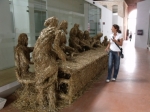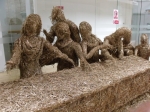The installation presented at pavilion of the Republic of Belarus at 54th Venice Biennale 2011
Text: Mikhail Miroshnikov.
Photo: Bekir Smolskij.
A town-planner by education and a conceptualist by calling, Artur Klinau perfectly creates a composition and a perspective of his works.
In late 1990-s the artist noticed the traditional Belarusian material – straw. The recent years his projects with straw arches and interiors “Sweet Straw Life”, “Straw Empire”, “The Secret Life of Straw” were presented in Bonn, Marseille, Strasbourg, Minsk and Vilnius. These works were used in the first Belarusian mystical thriller “Masacra", created in 2010 by Andrei Kudinenko at the National Film Studio “Belarusfilm”.
The artist has always been interested in the theme of death. In 1990s he created the installation that included elements of architecture and Catholic’s ritual attributes. The interest in supernatural ideas urged Klinau on the interpretation of the fresco by Leonardo da Vinci "The Lord’s Supper" *. If Leonardo da Vinchi used tempera on resin, plaster or mastic, Joseph Beuys used felt, then Artur Klinau uses straw (traditional material for Belarus). His skill of creating frame for Christ and the apostles’ figures, his really Belarusian diligence in straw binding is really amazing. The Christian sacrament of the Eucharist, The Communion in the Species of Wine and Bread, presented in the "The Lord’s Supper" by A. Klinau - is all his conceptual experience concentrated in a work.
*"The Lord’s Supper" (Italian: Il Cenacolo or L'Ultima Cena) is a fresco by Leonardo da Vinci (1452 - 1519) with a scene of Christ's last supper with his followers. The fresco was created in 1495 - 1498 on the wall of Dominican monastery of Santa Maria delle Grazie in Milan for his patron Duke Ludovico Sforza and his wife Beatrice d'Este. The size of the image is about 450 × 870 cm. It is considered that the fresco depicts the moment when Jesus announces that one of his Twelve Apostles would betray him, and eventually come back to save him. The painting became a developmental milestone in the history of the Renaissance: correctly reproduced depth of perspective changed the development of painting of the West.



